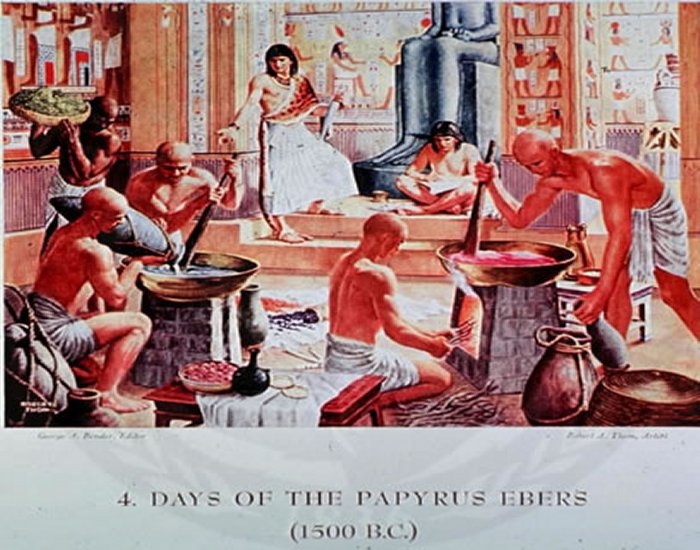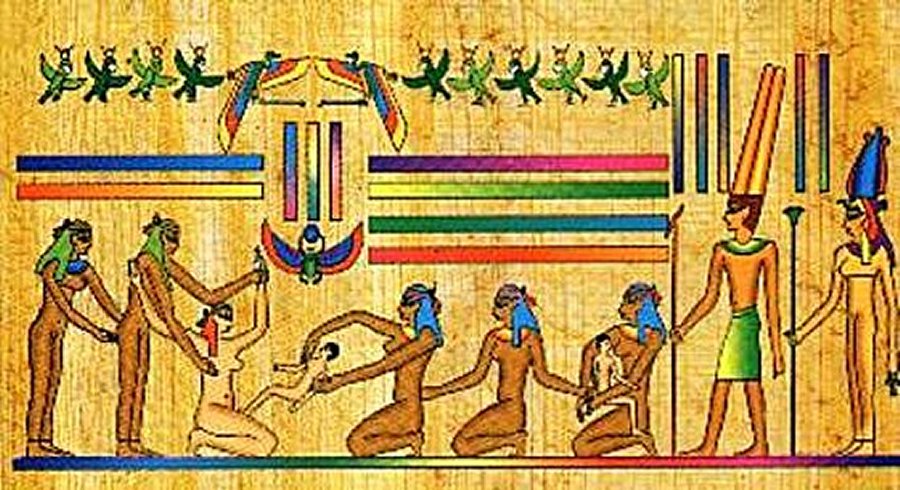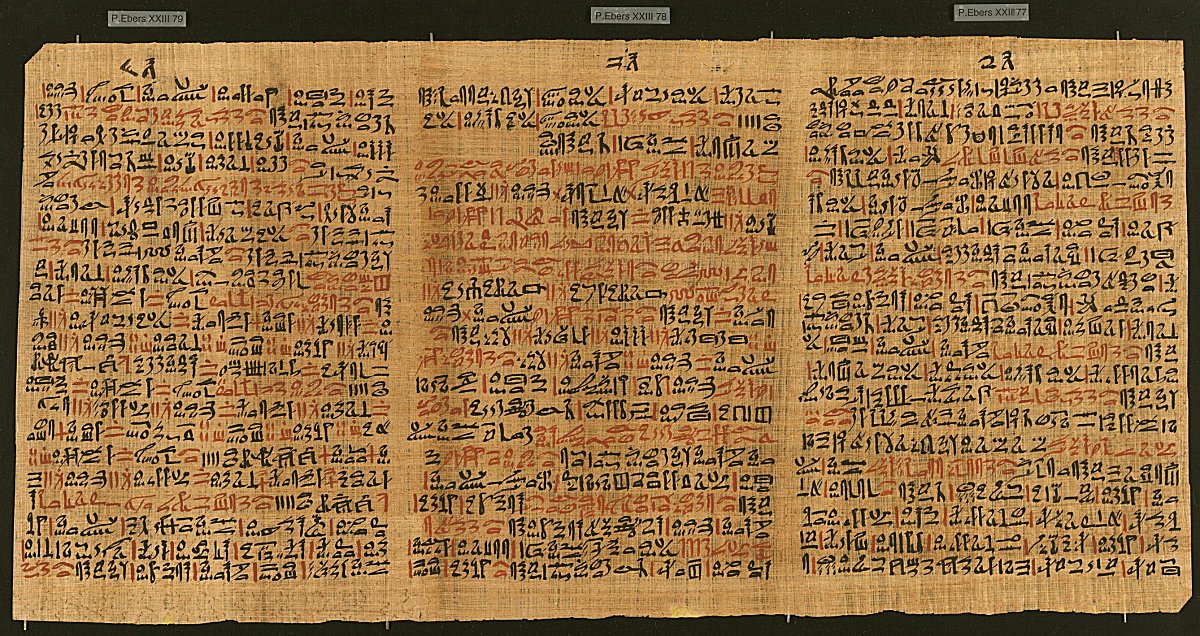The Ebers Papyrus – Most Famous Plant Medicine ‘Encyclopedia’ Of Ancient Egypt
A. Sutherland - AncientPages.com - Herbal medicine was considered complementary medicine in ancient Egypt and it played a key role in society. Ancient Egyptian scrolls document natural herbs and holistic medicine that saved lives and cured disease.
Evidence comes from burial sites, tombs, and underground temples where archeologists have found extensive sets of medical documents and scrolls, including the Ebers Papyrus.
The Ebers Papyrus – the most famous plant – medicine “encyclopedia” – is among several other ancient medical scrolls. A 110-page scroll, which rolls out to be about 20 meters long was found between the legs of a mummy in the Assassif district of the Theben necropolis. Photo: via Naturale clinic
The Ebers Papyrus – the most famous plant – medicine “encyclopedia” – is among several other ancient medical scrolls.
A 110-page scroll, which rolls out to be 20.23 meters in length and 30 centimeters in height, was found between the legs of a mummy in the Assassif district of the Theben necropolis.
It is unclear who the seller was, but the document was purchased in Luxor by Edwin Smith in 1862 and remained in his collection until at least 1869 when there appeared, in the catalog of an antiquities dealer, an advertisement for “a large medical papyrus in the possession of Edwin Smith, an American farmer of Luxor.”
Ten years later, the Papyrus was purchased in 1872 by the Egyptologist George Ebers, for who it is named. In 1875, Ebers published a facsimile with an English-Latin vocabulary and introduction.
This particular reference to the Lower Egyptian Den suggests its origin closer to the First Dynasty (c. 3000 B.C.E.)
The Ebers Papyrus is by far the most lengthy of the medical papyri and it is dated to the 9th year of the reign of Amenhotep I (c. 1534 B.C.E.).
However, it is believed to have been copied from earlier texts or it could be much older because paragraph 856a states that: “the book of driving wekhedu from all the limbs of a man was found in writings under the two feet of Anubis in Letopolis and was brought to the majesty of the king of Upper and Lower Egypt Den.”(Nunn 1996: 31)
The Ebers Papyrus contains magical spells designed to protect from supernatural intervention on diagnosis and treatment. There is also a large section describing different diseases of the stomach, intestinal parasites, skin and eye diseases and diseases of the anus, and many more.
It describes several treatments and is full of prescribed remedies along with a large list of prescriptions to relieve medical ailments.
Several paragraphs contain remedies that are believed to have been made and used personally by various deities; in paragraph 247, for example, there is a note relating to Isis’ creation of a remedy for an illness in Ra’s head, and the document mentions a specific diagnosis.
Here are some remedies from the ancient Ebers Papyrus scrolls:
Aloe vera was used to alleviate burns, ulcers, skin diseases, and allergies
– Basil was written up as heart medicine
– Balsam Apple (Apple of Jerusalem) was used as a laxative and as a liver stimulant
– Bayberry was prescribed for diarrhea, ulcers, and hemorrhoids
– Caraway soothed digestion and was a breath freshener
– Colchicum (citrullus colocynthus or meadow saffron) soothed rheumatism and reduced swelling
– Dill was recognized for laxative and diuretic properties
– Fenugreek was prescribed for respiratory disorders and to cleanse the stomach and calm the liver and pancreas
– Frankincense was used for throat and larynx infections, and to stop bleeding and vomiting
– Garlic was given to the Hebrew slaves daily to give them vitality and strength for building the pyramids
– Licorice was utilized as a mild laxative, to expel phlegm, and to alleviate chest and respiratory problems
– Onion was taken to prevent colds and to address cardiovascular problems (How did they know?)
– Parsley was prescribed as a diuretic
– Thyme was given as a pain reliever and Tumeric for open wounds
– Poppy was used to relieve insomnia, as an anesthetic, and to kill the pain
– Coriander was taken as a tea for urinary complaints, including cystitis
– Pomegranate root was strained with water and drunk to address “snakes of the belly” (tapeworms). The alkaloids contained in pomegranate paralyzed the worms’ nervous system and they relinquished their hold.
– Persian henna was used against hair loss
The papyrus also covers subjects such as dementia, depression, and contains chapters on the diagnosis of pregnancy, several different gynecological matters, contraception, dentistry, and the surgical treatment of burns, tumors, and bone-setting. There is also described the treatment of migraines.
The Ebers Papyrus is currently kept at the library of the University of Leipzig, in Germany.
Written by – A. Sutherland - AncientPages.com Senior Staff Writer
Copyright © AncientPages.com All rights reserved. This material may not be published, broadcast, rewritten or redistributed in whole or part without the express written permission of AncientPages.com
Expand for referencesMore From Ancient Pages
-
 Roman Marble Head Found In Lake Nemi Could Be From Caligula’s Legendary Ships
Archaeology | Jun 28, 2023
Roman Marble Head Found In Lake Nemi Could Be From Caligula’s Legendary Ships
Archaeology | Jun 28, 2023 -
 On This Day In History: Battle of Salamis Was Fought – On Sep 22, 480 BC
News | Sep 22, 2016
On This Day In History: Battle of Salamis Was Fought – On Sep 22, 480 BC
News | Sep 22, 2016 -
 Mysterious Ancient Dark Object Hidden In The Colorado Mountains – What Happened To It?
Featured Stories | Jun 17, 2024
Mysterious Ancient Dark Object Hidden In The Colorado Mountains – What Happened To It?
Featured Stories | Jun 17, 2024 -
 Giants Did Exist And Were A Part Of Earth’s Ancient History
Featured Stories | Apr 29, 2014
Giants Did Exist And Were A Part Of Earth’s Ancient History
Featured Stories | Apr 29, 2014 -
 Mungo Man Finally To Rest In Peace After 42,000 Years – Reburial Approved After Federal Decision
News | Apr 8, 2022
Mungo Man Finally To Rest In Peace After 42,000 Years – Reburial Approved After Federal Decision
News | Apr 8, 2022 -
 Evidence Of Ancient Lakes In The Sahara Desert Discovered
Archaeology | Nov 5, 2022
Evidence Of Ancient Lakes In The Sahara Desert Discovered
Archaeology | Nov 5, 2022 -
 How Climate Change Contruibuted To The Transition From Nomadic Hunter-Gatherers To Settlement And Farming Societies
Archaeology | Nov 27, 2021
How Climate Change Contruibuted To The Transition From Nomadic Hunter-Gatherers To Settlement And Farming Societies
Archaeology | Nov 27, 2021 -
 Medieval Mystery Of The Booted Man Found In The Thames Mud
Archaeology | Dec 10, 2018
Medieval Mystery Of The Booted Man Found In The Thames Mud
Archaeology | Dec 10, 2018 -
 Ruins Of Post-Medieval Brunell Township Discovered In Glen Brittle Forest On The Isle of Skye
Archaeology | Feb 29, 2024
Ruins Of Post-Medieval Brunell Township Discovered In Glen Brittle Forest On The Isle of Skye
Archaeology | Feb 29, 2024 -
 On This Day In History: Supernova Observed In The Constellation Cassiopeia Was Recorded – On August 4, 1181
News | Aug 4, 2016
On This Day In History: Supernova Observed In The Constellation Cassiopeia Was Recorded – On August 4, 1181
News | Aug 4, 2016 -
 Peculiar Unsolved Greek Mystery In New York
Featured Stories | Mar 26, 2024
Peculiar Unsolved Greek Mystery In New York
Featured Stories | Mar 26, 2024 -
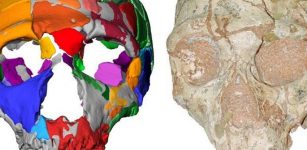 Mysterious 210,000-Year-Old Apidima Skull Could Re-Write Human History
Archaeology | Jul 11, 2019
Mysterious 210,000-Year-Old Apidima Skull Could Re-Write Human History
Archaeology | Jul 11, 2019 -
 Mystery Of The Yaghan People: The First True Discoverers Of America?
Civilizations | Sep 19, 2016
Mystery Of The Yaghan People: The First True Discoverers Of America?
Civilizations | Sep 19, 2016 -
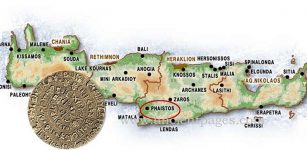 Is The Mystery Of Controversial Phaistos Disk Solved?
Archaeology | Dec 17, 2015
Is The Mystery Of Controversial Phaistos Disk Solved?
Archaeology | Dec 17, 2015 -
 Famous Viking Ragnar Lodbrok – Legendary Fearless Sea-King Of The North
Featured Stories | Apr 24, 2016
Famous Viking Ragnar Lodbrok – Legendary Fearless Sea-King Of The North
Featured Stories | Apr 24, 2016 -
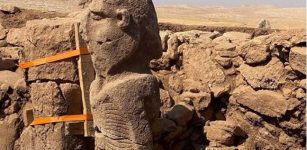 World’s Oldest Human Statue Discovered At Karahan Tepe, Turkey
Archaeology | Oct 30, 2023
World’s Oldest Human Statue Discovered At Karahan Tepe, Turkey
Archaeology | Oct 30, 2023 -
 Neolithic Monuments, Prehistoric Pits And Anglo-Saxon Cemetery Unearthed In England
Archaeology | Apr 19, 2016
Neolithic Monuments, Prehistoric Pits And Anglo-Saxon Cemetery Unearthed In England
Archaeology | Apr 19, 2016 -
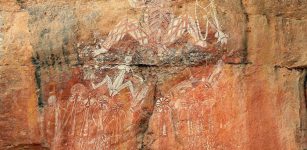 Machine-Learning Model Can Detect Hidden Aussie Rock Art
Archaeology | Jun 28, 2022
Machine-Learning Model Can Detect Hidden Aussie Rock Art
Archaeology | Jun 28, 2022 -
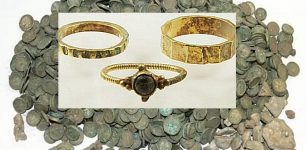 900-Year-Old Coins And Jewelry Unearthed In Polish Village – Could They Belong To A Ruthenian Princess?
Artifacts | Jan 12, 2021
900-Year-Old Coins And Jewelry Unearthed In Polish Village – Could They Belong To A Ruthenian Princess?
Artifacts | Jan 12, 2021 -
 The Faery Grail Of Hospitality And Accord- The Forgotten Story – Part 1
Featured Stories | Sep 25, 2019
The Faery Grail Of Hospitality And Accord- The Forgotten Story – Part 1
Featured Stories | Sep 25, 2019

